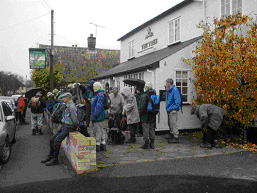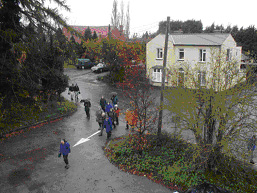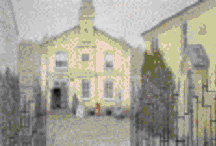** Please note that this is an archive of the CANTAB publication and contains out-of-date information **
CANTAB RAMBLER
West Anglian Way Nov. 2002 – Feb. 2003
Nov. 2002 – Feb. 2003
A heron motif is featured on the West Anglian Way Certificate.
The finale of the six walks from Cambridge to Cheshunt was completed on 22 February, on a day which turned out fine and Spring-like after a misty start. Some 45 people walked from Broxbourne to Cheshunt, via Waltham Abbey, ably led by Mark Westley.
During a short lunch-time presentation, in the garden of The Coach & Horses Inn (illustrated left) 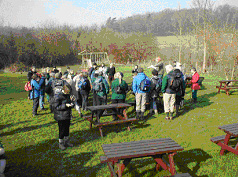 some 19 walkers received certificates and congratulations for completing the whole 65 mile route. These comprised 9 Cambridgeshire members, 6 East Herts members, 2 from North Herts, and 2 from Royston.
some 19 walkers received certificates and congratulations for completing the whole 65 mile route. These comprised 9 Cambridgeshire members, 6 East Herts members, 2 from North Herts, and 2 from Royston.
Quite a large proportion of the walk was in Essex where relatively few problems were encountered. However, on the penultimate section, walkers needed to bypass a barbed wire fence obstruction to Footpath 78 across North Cannons golf course at Roydon Mead. Complaints have been passed to Essex County Council about this, the only serious obstruction.
Thanks to all who helped organise, and all who came on this popular joint Cambridge-East Herts Group event.
It is hoped that it will be possible to have The West Anglian Way marked on future Ordnance Survey sheets, and that a leaflet or small booklet will be available in due course. It would be helpful to have feedback on preferred content: an outline leaflet of the route with basic instructions produced cheaply, or a more elaborate booklet with points of interest, illustrations and maps? As a general point, do users keep walking guidebooks they have used as souvenirs of the route(s), maybe annotated with notes, with a possibility of repeating the traverse, or leading others along it? Or when a route is completed, is the rain-stained guidebook passed to a friend or consigned to oblivion in the recycling tray?
And how many of the folk present are “addicted” to long distance paths, and veterans of The 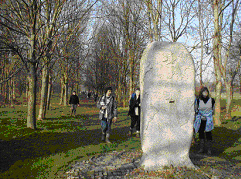 Icknield Way, The South Downs Way etc? Was there anyone for whom this was their first long distance route?
Icknield Way, The South Downs Way etc? Was there anyone for whom this was their first long distance route?
The Meridian Stone near Waltham Abbey.
Photos courtesy Mark Westley.
Parish of the Month –
Great & Little Chishill, South Cambridgeshire.
Landranger 154; Explorers 209, 194; Pathfinders 1027, 1050
Scenically, geographically, and historically, this parish is amongst the most notable in South Cambridgeshire District, and well worth a prolonged visit.
History of Chishill *(1, 2)
The parishes of Great & Little Chishill were amalgamated into one in 1967, and together cover 1300 hectares, lying across a steep chalk escarpment, rising from 40m at the A505, to a high point of 146m. The open village fields were enclosed in 1818. In Domesday Book, the name is given as Chishelle, meaning “gravel hill”, and referring to patches of gravel overlying the chalk in higher places. The parish was part of Essex until 1895, when together with Heydon, it was transferred to Cambridgeshire.*(2) The Icknield Way (IW) routes passing through the parish were already important in the Neolithic and Bronze ages, with at least 40 ring-ditches known from the air. The IW continued in use as a long distance path (LDP) in the Middle Ages, and strip lynchets survive from medieval ploughing on Chishill Down, TL 423 400. Contemporary use still takes the Icknield Way LDP through Chishill on the old trackway. Great Chishill’s C15th church (with a modern tower) stands on a prominent mound at the village cross-roads. Little Chishill Church stands beside what is now only a hamlet, and is best reached on foot from Great Chishill via the byway running S from May Street at TL 420 384.
After cresting the hill, the track becomes a sunken lane, descending past the gardens of Little Chishill Manor, to emerge on the Little Chishill road at TL 419 374, almost opposite the church. A public footpath crosses Little Chishill churchyard and exits between trees over a stile in the rear fence. The right of way crosses a grass field to a stile in a crossing fence, and continues W, across an arable field to a wooden bridge at the county boundary spanning “Water Lane”. A continuing path leads to Shaftenoe End, Herts, whence a return may be made to Chishill via the minor road.(3.5 miles).
Cambridgeshire’s highest point,
146m (480ft) is situated near the county boundary at Great Chishill at TL 427 380, about 400m S of the B1039, where a grassy triangle marks the driveway leading to The Hall (rather hidden in trees).
From here, a bridleway runs across the arable field towards Building End. Continuing, a good 11 mile walk (*3) can be had via tracks and paths to Langley Church, Duddenhoe End, Chiswick Hall, the isolated Chrishall Church, Chrishall village, and along the line of the Icknield Way Long Distance Path back to Chishill village. Parking for this walk, however, is better in the village itself, where there is a small car park near the telephone box, TL 423 388, close to The Pheasant Inn.
Great Chishill Windmill
Also of interest is the attractive preserved postmill, sited at TL 413 388 outside the village on the B1039 towards Barley. This mill, which last worked in 1951, was rebuilt in 1819, using timbers from an earlier mill of 1726. The modern restoration has left the sails without shutters and a rather odd skeleton of a fan has been provided. The mill is, however, complete internally, having 2 pairs of stones, and all-wood gearing except for a cast-iron windshaft (*4). Keys may be obtained from houses in the village. The mill is maintained by Cambs.C.C., who provide a display board, a small car-park and picnic area. A well-maintained public footpath leads from behind the adjacent garden towards Chishill village centre. At the crossroads stands the village sign illustrating the mill.
The Parish Pit
Leave the village cross-roads NE, and shortly turn NW down New Road. At TL 423 392, a green metal sign in the hedge indicates a track between gardens, then round a field edge to enter the old parish clunch pit, which is maintained as a nature reserve.
The public footpath through the pit runs generally NE, as a narrow earth track between rampant vegetation to emerge on another footpath at a T-junction, TL 425 393. From here, turn right (uphill) on a narrow path between a stream and hedge, to return to the village. This footpath exits at TL 426 391 onto Heydon Road, Great Chishill, a short walk from the crossroads.
Alternatively, for a longer walk of 4 miles, turn left (downhill). The path at first is a narrow defile, with the trees of the former clunch pit to left, and a stream to right. Soon, the path opens to fields on the left, with wide views over the Cam Valley. It continues to New Buildings Farm, then still NW to join the ancient Icknield Way track, by a signpost at TL 410 418. Turn right along this green lane, between intermittent hedges. The byway along the line of the ancient Icknield Way trackway continues in the parish of Heydon, reaching a marker post at TL 412 420, near a copse. Turn right uphill, now following the line of the Heydon Ditch (an early Anglo-Saxon fortification). At first this is a raised grassy baulk between arable fields. As it climbs the hill, it becomes a hedged path, later between high banks, and finally emerges between gardens by a footpath signpost with Icknield Way markers on Fowlmere Road, Heydon, at TL 431 405. Walk S up the footway towards Heydon Church (bombed in 1940, observe the brick restoration) then turn right along the road, passing the King William IV Inn, and the Wood Green Animal Shelter.The former provides food, and visitors & donations are welcome at the latter!
* (1) Archaeology of Cambridgeshire. Vol.1 South West Cambridgeshire by Alison Taylor. Publ. Cambs.C.C.1997, pp.29 – 30.
* (2) An Atlas of Cambridgeshire and Huntingdonshire History. Ed. T.Kirby, S. Oosthuizen, Publ.Anglia Polytechnic Univ. 2000.
* (3)Full description – walks in South Cambridgeshire, 2nd. Ed. 1993.Walk 13. Publ. Cambridge RA Group.
* (4)Batsford Guide to the Industrial Archaeology of East Anglia, by D.Alderton & J.Booker, 1980, pp. 43 -44.
Changes to the Definitive Map in Cambridgeshire
The following information is extracted from Cambs.C.C. Annual Report of Changes to the Definitive Map, as made by Legal Order in the year 1 April 2001 to 31 March 2002. Some of the new paths have been available on the ground for some time already.
Because of Ordnance Survey copyright restrictions, we are not able to reproduce any maps here, but the following grid references will allow readers to annotate their maps.
Whittlesey Bridleways 59, 60, 61
Paths near railway: grid refs. TL 291965 to TL 298 966
A section of Fp 41 has been upgraded to Br 59, & a section of Fp 48 upgraded to Br 60.
The bridleways were created by agreement with landowners, Sustrans Ltd., and by upgrading 2 sections of footpath, total length ca. 650m, forming part of a National Cycle Route.
March Footpath 10
Part of footpath 10 between Camargue Drive and Cavalry Park was extinguished as part of housing development. Grid refs TL 417 955 to TL 417 956.
Grantchester Footpath 12 (part)
A path was created alongside the M11, near its junction with the Barton Road, A603, opposite Haggis Farm. Grid refs TL 417 562 to TL 420 561. The footpath was created by Cambs.C.C, by agreement with landowners.
Fenstanton Bridleways 16,17,18,19
Rights of Way have been added to connect two existing subways under the A14. Grid refs TL 314 684 , TL 317 681
Dry Drayton Footpaths 17, 19
Footpath 17 from behind the church has been re-aligned to follow field boundaries, mostly beside a little stream. Footpath 19 is a new path created by agreement with landowners, to join a point along Fp 17 to Scotland Road, almost opposite Br 18. Grid refs TL 374 612 to TL 379 613
Willingham Bridleway 12
A new bridleway was created by agreement with landowners, Hanson Quarry Products, running ca 2.9km from West Fen Road, Willingham to No 18 Drove, S of Earith. It runs roughly parallel to the B1050 , generally one field width from the road. Grid refs. TL 392 745 to TL 395 729
Swaffham Prior Footpath 6
A short section of this path near Pulpit Corner, was diverted by East Cambs.D.C. to Heath Road, as part of a housing development. Grid refs. TL 374 612 to TL 379 613
Wicken Footpath 28
A short path from Wicken High Street to Back Lane was extinguished, as it appeared to the Authority (East Cambs.D.C.) that it was not needed for public use. (Redit Lane goes through between the two roads a short distance away). Grid ref TL 568 707
Holywell cum Needingworth Bridleways 17,18 and Footpath 19, and Bluntisham Bridleway 14
Bridleways of ca 1.9km length, and a footpath of ca. 1.3km were created by Cambs.C.C., by agreement with Hanson Quarry Products Ltd., and another landowner. Grid refs. TL 348727 to TL 357 715 (Br) and TL 363 719 (Fp)
(Part of) Ely Footpath 35
A section of Footpath 35, total length ca.65m, was extinguished by Cambs.C.C, as it appeared to the Authority that it was not needed for public use (now being an adopted highway by Jubillee Terrace, off Cutter Lane). Grid refs. TL 543 798 to TL 544 798
Path News…
Great Chesterford Bridleway Bridge now reopened
Walkers on the Icknield Way were subject to a long detour for some weeks until after Christmas when the bridle bridge was closed over the M11 at TL 502 422, on the long path from Strethall Field to Great Chesterford. The editor can confirm that the bridge and path are now reopened. The bridge now has new high-level shuttering, designed to shield horses from the distracting view of the traffic on the M11.
Bourn Footpath 2
This long path runs from Caxton End at TL 317 576 to Broad Way at Great Common Farm, TL 335 593. As anyone familiar with the locality can imagine, this once pleasant footpath has become entangled with the eastern edge of Cambourne. Eventually, part of the path will run through a landscaped area and past a lake, then along what we hope will be a green corridor between further housing development. At present “brown” would be a better description than “green”(!), and the developers have proceded to dig out the lake, and block the route before seeking a formal diversion, or even consulting with user groups. A temporary diversion is now in place, only after a local user found “path closed” notices.
Caldecote Bridleway 3
This narrow bridleway, running east from the road at Highfields, TL 351 582, to join Bridleway 4 alongside Hardwick Wood, has for many years been almost unusable by walkers in Winter’s deep mud. The fenced path is defined as a mere 10 ft wide, and in practice is usually less, due to the adjacent hedge. Karen Champion, with Cambs C.C’s Countryside Services Team, reports that work on improving this route has recently been completed.
Fulbourn Footpath 15
The footpath following Caudle Ditch along the Teversham parish boundary to join Little Wilbraham River at TL 518 589 has long been subject to bushy overgrowth. But Karen Champion of Cambs.C.C. now reports work by 40 servicemen from Waterbeach base have now cleared this valuable and attractive route.
Roger Moreton
Cantab Rambler by E-Mail & Post
Cantab usually appears every two months. A large number of you now receive Cantab by e-mail. By hand, 10p is appreciated towards the cost of paper and ink. If you would like to receive an issue by post, please send a large SAE, and a 10p stamp.
Offers of brief articles will be gratefully received.
This is a privately produced magazine, and the views expressed are solely those of the editor, or of the author of an individual item. Janet Moreton 01223 356889
e-mail roger.janet@care4free.net
Price 10 pence where sold © Janet Moreton, 2003

